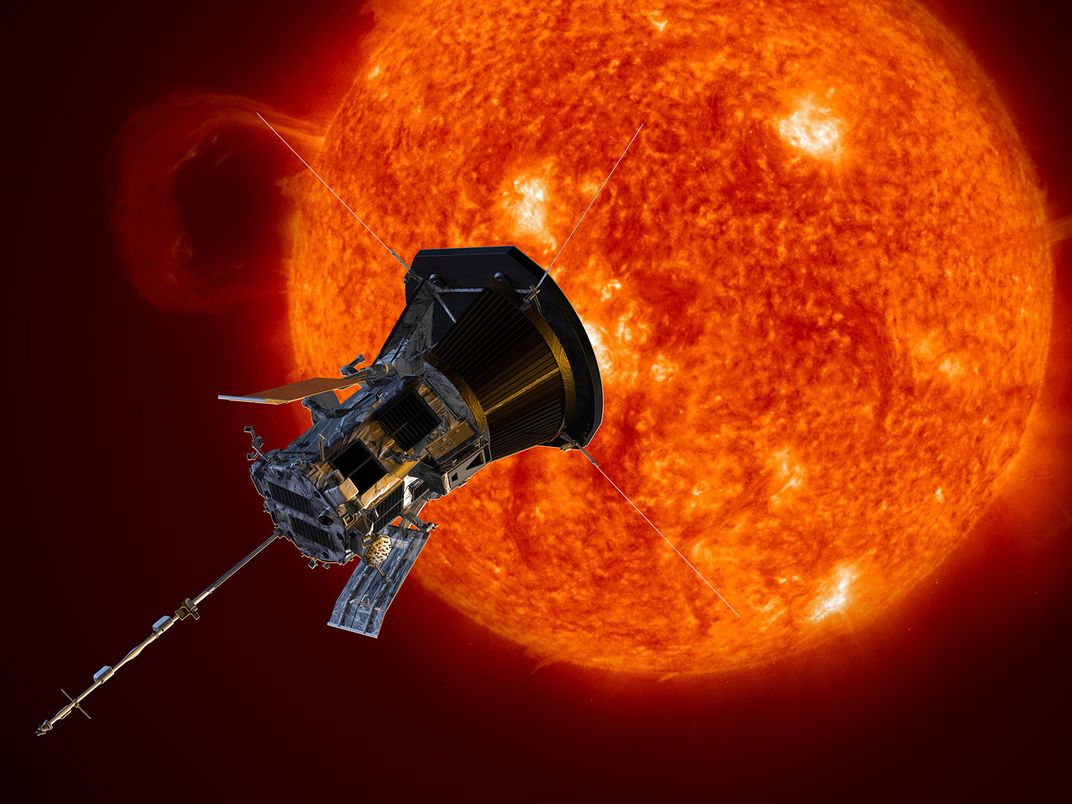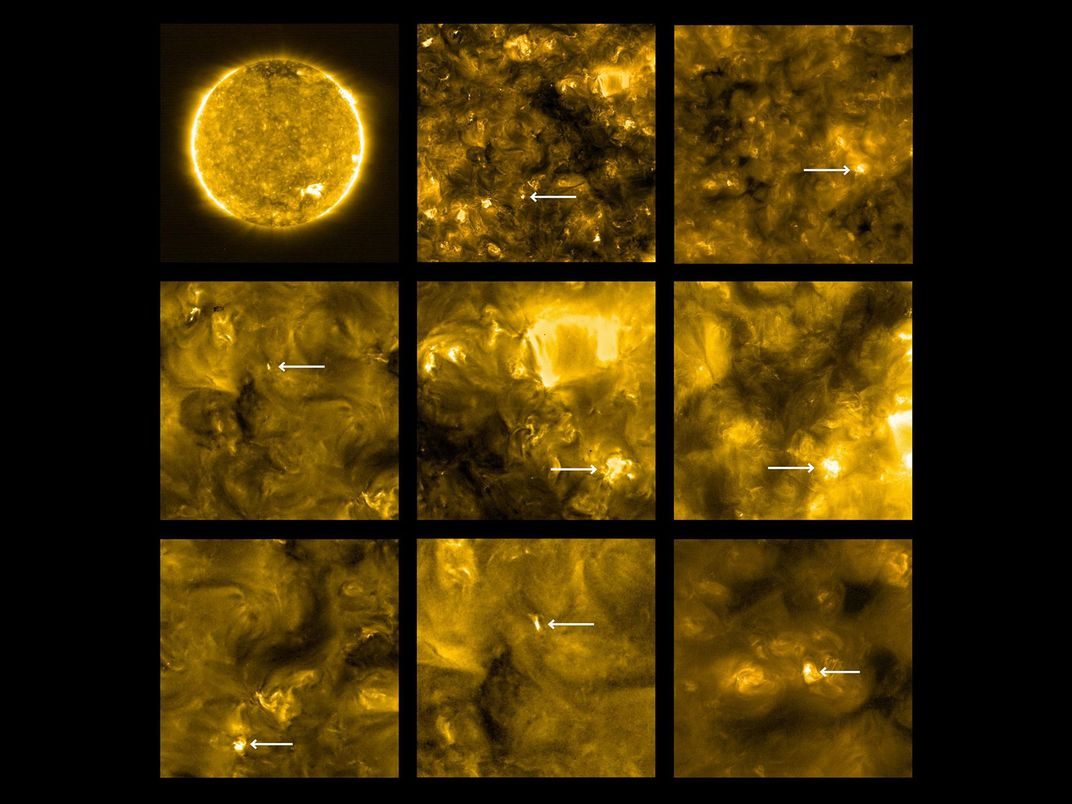How Three New Tools Will Revolutionize Our Understanding of the Sun
Two spacecrafts and a telescope are set to jumpstart a new age of solar astronomy
:focal(1150x731:1151x732)/https://tf-cmsv2-smithsonianmag-media.s3.amazonaws.com/filer/81/2d/812df55d-3103-4780-9070-1a620c1a5c24/solar_orbiter_and_parker_solar_probe_web.jpg)
The sun may be our closest star but it has managed to keep a few big secrets hidden. Now a trio of solar telescopes are kicking off a new era of solar astronomy that has scientists excited about major potential discoveries. NASA's Parker Solar Probe is currently on its way to “touch” the sun—the spacecraft will make the closest orbit around Earth's nearest star, flying through the sun’s atmosphere, in 2025. The Solar Orbiter, a spacecraft launched as part of a joint mission between the European Space Agency (ESA) and NASA, will become the first mission to study the solar poles. Back on Earth, the National Science Foundation (NSF's) Daniel K. Inouye telescope will make the most detailed ground-based observations of the sun, providing broader context for the pair of satellites.
"[These missions] will revolutionize solar physics during this decade," Yannis Zouganelis, deputy project scientist for the Solar Orbiter mission, writes in an email.
Scientists are hoping to learn a host of new things, but two big issues have vexed them for decades. Chief among those is the coronal heating mystery. In a bonfire on earth, for instance, temperatures are highest at the source and decrease further away from the blaze. Not so with the sun. Although the solar surface is a toasty 5,500 degrees Celsius (9,940 degrees Fahrenheit), the layer above it, the corona, blazes even hotter at a more than a million degrees. By probing the atmosphere, scientists hope to figure out the cause of the strange temperature reversal.
The other big ongoing puzzle involves solar wind, the wave of charged particles released by the sun and blown outward in all directions. When this material from the sun hits Earth, it can cause stunning aurorae, damage satellites, and overcharge power grids. Astronauts in space can be especially hard-hit by the radiation. Scientists are hoping to piece together what accelerates the solar wind and the charged particles blown off the sun.
Here is more about how these three important tools operate:
The Parker Solar Probe
Although the Parker Solar Probe launched in 2018, it still hasn't reached its final orbit inside the sun's atmosphere, where it will make the most in-depth measurements of the corona. But getting that close takes time, and a little help from Venus' gravity. Over seven years, starting in 2018, the spacecraft will make a series of seven fly-bys, each one pushing it a little closer to the sun. Eventually, Parker will orbit within 3.8 million miles of the star, closer than any mission has come before. Ultimately, the spacecraft will hover in the solar atmosphere, making the first in situ measurements of the corona, examining the electromagnetic fields, particle acceleration, wave activity, and energy distribution. It will also be close enough to image the solar wind as it accelerates to supersonic speeds.
To safely explore these extreme conditions, 4.5-inch-thick (11.43 cm) carbon-composite shields protect the Parker Solar Probe and its instruments from the scathing heat. "Parker's advantage certainly is the breakthrough technology that deals with the intense heat the sun creates on the sun-facing side of the spacecraft," writes NASA scientist Arik Posner, a member of the Parker Solar Probe team, in an email. "Without it, we wouldn't be able to make much progress beyond reaching Mercury's distance."

The spacecraft carries four instruments that will study the environment around the probe. The only imager on board, WISPR, will collect up-close images of structures like coronal mass ejections in the solar atmosphere before the spacecraft flies through them, helping to connect the detailed physical measurements to the larger structure of the sun. FIELDS will capture the scale and shape of electric and magnetic fields in the atmosphere. SWEAP will count the most abundant particles in the solar wind and measure properties like the wind’s velocity, density and temperature. ISʘIS, which includes the symbol for the sun in its acronym, will measure particles to understand where they come from, how they become accelerated and how they leave the sun.
Although the spacecraft is still moving towards its closest approach, it is already collecting important observations. Results from its first two solar flybys, released in December 2019, revealed that the solar wind was released farther from the sun than previously thought and that the solar wind traveled as much as ten times faster horizontally along the sun than previously thought. Posner writes it was "a problem that we had considered settled more than 50 years ago." Knowing the solar wind’s speed will help scientists understand the sun's rotation.
The Parker Solar Probe’s first observations also revealed flips in the sun's magnetic field known as 'switchbacks.' In those regions, the sun’s magnetic field is folded back in on itself to create an area of enhanced turbulence. According to Posner, switchbacks and the solar rotation may be "closely linked" to one another.
Posner is confident that these two big finds are only the first of many clues that the spacecraft will uncover. "There are several important discoveries made by Parker Solar Probe already, but many more to come," writes Posner.
Solar Orbiter
Launched on February 10, 2020, the ESA's Solar Orbiter carries six remote-sensing telescopes capable of snapping photos of the sun and four instruments that will measure the environment surrounding the spacecraft. The craft is on a path that will allow it to capture the closest images of the solar surface ever taken. Comparing the data collected from both sets of instruments will allow scientists to gain insights into solar wind.
By taking images from farther away, the spacecraft will help place the Parker Solar Probe’s observations in context. "If [the Parker Solar Probe] is the mission that 'touches' the sun, Solar Orbiter is the mission that sees it!" Zouganelis writes via email.
Instead of orbiting the star along the ecliptic, or the plane parallel to its equator, Solar Orbiter will have a highly inclined orbit that will give us a first glimpse of the solar poles. In the 1990s, the ESA's Ulysses spacecraft became the first mission to escape the ecliptic, but it lacked the instruments that would capture images of the sun. According to Zouganelis, the poles are poorly imaged from Earth as well. "Seeing the polar regions is key for our understanding of how the magnetic fields of the sun are created, distributed, and vary," Zouganelis writes.
/https://tf-cmsv2-smithsonianmag-media.s3.amazonaws.com/filer/18/86/1886b8a6-ab20-4735-8cbe-de810ba721b7/solar_orbiter_artist_impression_20190916_1_web.jpg)
The Solar Orbiter will also probe the solar dynamo, the physical process that drives the magnetic fields. Magnetic loops rise to the surface of the sun, where they are stretched and sheared by the sun's rotation, which varies in different regions. The resulting eruptions cast dense collections of charged particles into space, where they can potentially collide with Earth and other planets, affecting space and terrestrial systems. "Understanding the complex physical processes at work in this system is the central goal of heliophysics," Zouganelis writes. Knowing how they all work together could help researchers predict when a blast of charged particles is aimed at Earth or other worlds explored by humans, allowing them more time to prepare for the incoming potential peril.
Although the spacecraft only started its science phase in June, working with the predominant goal of checking the health of its instruments, its telescopes have already discovered never-before-seen "campfires," miniature flares comparable to previously predicted nanoflares. The mission's first ultraviolet image revealed a multitude of small flaring loops, erupting bright spots, and dark moving jets of plasma. Although they've been observed previously at different wavelengths, "this time we see them everywhere all over the solar disk; they seem to be ubiquitous," Zouganelis writes.

Inouye Solar Telescope
While the Parker Solar Probe and Solar Orbiter both monitor the sun from space, the Daniel K. Inouye Solar Telescope studies the star from atop Haleakala mountain in Hawai'i. Originally planned to begin its science in the summer of 2020, the giant solar telescope suffered from delays caused by the Covid-19 pandemic and now anticipates making its first observations in the spring of 2021.
The Inouye boasts the largest mirror of any solar telescope in the world, a 13-foot giant that allows it to collect more light than any other telescope. "Inouye can see more small-scale details than we've ever seen before," writes observatory director Thomas Rimmele, via email.
Light travels from the mirror to a suite of instruments beneath the telescope. Four of the five instruments probe how light is polarized at various wavelengths, allowing them to identify the conditions of the magnetic field throughout the sun's corona. "Unlike most existing telescopes, which can analyze the magnetic field at the surface of the sun, with the Inouye Solar telescope, we can for the first time obtain the magnetic field properties above the surface and into the corona," Rimmele writes.
Although Inouye has not begun full-time observations, the telescope saw first light in January 2020. With its first shots, Inouye revealed details that had never been seen before on such small scales. The images were so detailed that Rimmele writes the features weren’t well explained by existing theoretical models. "We need to adjust our thinking to better match what we see in the data," Rimmele writes. "This helps to evolve our understanding of the physics at play in a complex system like the sun."
Inouye hopes to tackle the coronal heating mystery. Scientists believe that the mystery is connected to the sun's magnetic field, and Inouye is designed to probe the magnetic field at higher resolution than previously accomplished. By studying sunspots, Inouye will also provide the first ongoing measurements of the properties of the magnetic field of the corona, which will help scientists delve into questions around the solar wind. "Every element of this telescope is cutting edge, and it already has the scientific community revisiting their assumptions," Rimmele writes.
All Together Now
While each of the observatories will make important discoveries on their own, they may best shine when they work together. While the Parker Solar Probe is bathed within the sun, it will be unable to place its observations in context with what is happening at other parts of the star. Both Solar Orbiter and the Inouye Telescope will provide a wide-scale look at regions that the Parker Solar Probe is immersed in. By observing the same part of the sun from different perspectives, the three instruments will be able to link detailed observations to broad oversights gleaned from farther away.
"The triad of NSF's Inouye Solar Telescope, ESA/NASA's Solar Orbiter, and NASA's Parker Solar Probe together beckon a new age of solar astronomy," Rimmele writes.
/https://tf-cmsv2-smithsonianmag-media.s3.amazonaws.com/accounts/headshot/NTR_headshot.jpg)


/https://tf-cmsv2-smithsonianmag-media.s3.amazonaws.com/accounts/headshot/NTR_headshot.jpg)